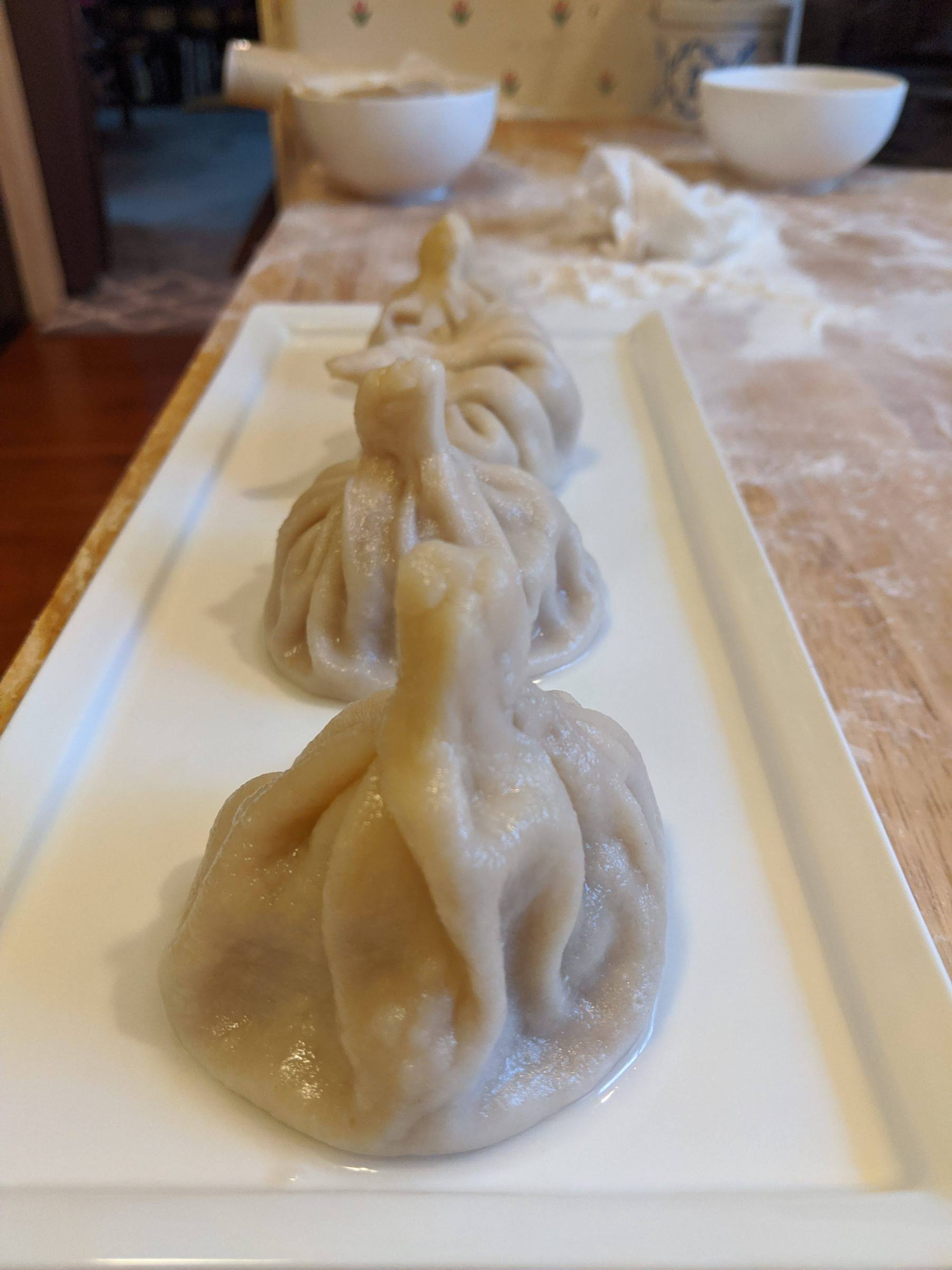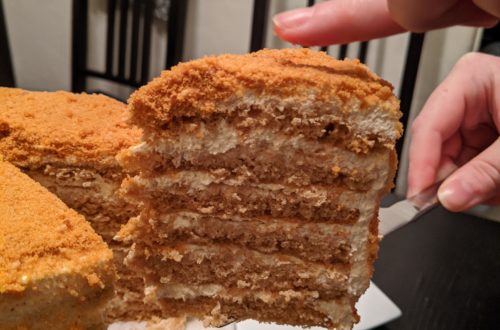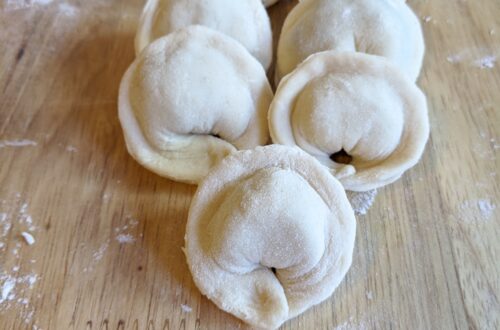Apparently I hadn’t had enough dumpling making after the pelmeni/vareniki day, so I jumped straight into making some Georgian dumplings, called Khinkali. To accompany this, we made some Khachapuri, a Georgian bread dish full of cheese and topped with an egg and butter. This was a heavy meal, and the cooking process did not exactly go to plan. But I’m out here sharing my successes and my failures, so let’s get to it.
I tried Khinkali for the first time at a Georgian restaurant in St. Petersburg . These are like a huge version of soup dumplings. They are intimidating the first time. They’re big and the process of eating them is not obvious. These are not bite size dumplings. The dumplings are large, with the dough pleated around the outside, meeting in the middle to form kind of a handle. You aren’t supposed to eat this handle. Proper technique involves picking up the dumpling by the knob of dough at the top, biting a hole in the bottom to suck out the soupy goodness, and then eating the solid meaty and pasta bits. The fancy restaurant where I had them provided vinyl gloves for picking them up and a pair of scissors so I didn’t have to bite into them like a barbarian. You eat everything except the doughy handle, and proudly display this around the edge of your plate. Apparently, it’s a mark of honor (and a way of settling shared bills) to display how many of these ginormous dumplings you could put down in one sitting.
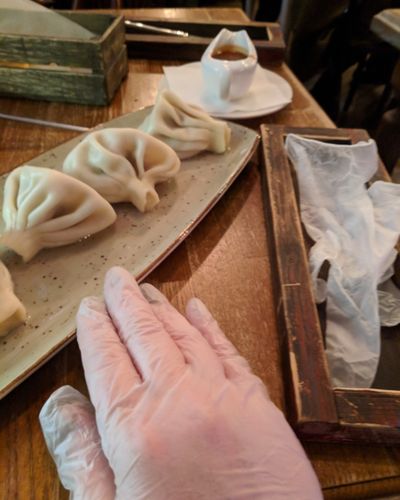
Khachapuri, on the other hand, is a magically delicious cheesy bread. The region of Georgia from where this originates is called Adjara and borders the Black Sea. The bread itself is a nod to the black sea, with the bread shaped like a boat, filled with cheese (a boat load of cheese!), sliced butter, and then topped with an egg to represent the sunset over the sea. It is beautiful and delicious. The correct ingestion technique for this beautiful creation is to pull the bread from the ends and sides and use it to dip into the cheesy pool in the middle.
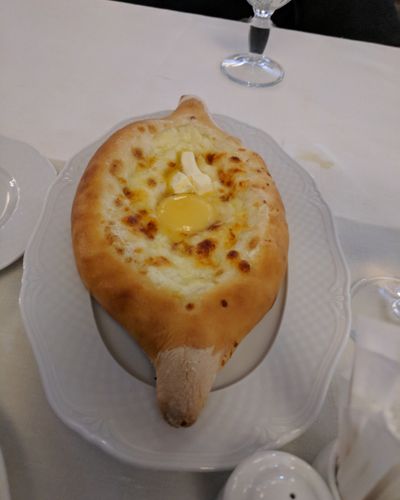
Making Dumplings
Having made pelmeni last week, I felt pretty confident in my dumpling making skills, so I just jumped right in. The process started with a simple noodle dough of just flour, water, and salt. I found a YouTube channel of an actual Georgian cook, and the video for this is here. I made a half recipe of the noodle dough, with 250 grams of flour, 1/2 cup of water, and 1/2 tsp of salt. I let the stand mixer do the hard work of bringing this very dry dough together, and then I wrapped it in plastic wrap and let it rest for half an hour.
Next, I made the filling. We had a half pound of ground lamb and a half pound of ground bison leftover, so I made 2 flavors of dumplings, but for each one, I followed the same seasonings. I diced a medium onion and then added ground coriander, salt, pepper, and paprika (about a teaspoon of each) and 1 teaspoon of minced fresh thyme leaves. She says ‘team’ in her recipe, so I guessed thyme. She also uses fresh coriander (cilantro), but I didn’t have any, so I went with ground coriander seeds. After mixing the onion and spices, I put half in the lamb and half in the bison. I then added 3/4 cup of water to each one and mixed all of the ingredients well. The water is there to make it more of a soup dumpling once it cooks. The meat shrinks a bit and holds together in the center, leaving a meatball suspended in a meaty broth, inside a noodle. At least, this is the idea.
I let the meats marinate for about an hour as I worked on the bread making for the Khachapuri, before assembling my dumplings. And that’s when the murders began… I mean, when things went a little sideways.
Having experience in dumpling making, I went on my merry way of cutting out circles of dough, rolling them out to pasta thickness, and then filling them with the liquidous meat. After a few rounds, I even got my dumpling pleating technique down. I took each dumpling dough circle, placed it in a small bowl to help with shaping, and then put a scoop of meat in the center. I pinched the edges together in one direction, then pleated the other side, and twisted in the center. (Just go watch the video, it’s hard to explain). Once complete, I dipped the bottom of each dumpling in flour to keep it from sticking to the work surface, and moved on to the next one. About halfway through the dumpling-ing, I noticed the ones that had been complete were…. leaking. Because of all the water in the filling, when the dumpling dough is thin, it can actually completely dissolve. So, in a panic, I took all of my completed dumplings and emptied their filling back into a bowl and tossed all of the now-soggy dough. I took all of the remaining dough and re-rolled it out into much thicker circles. We need lasagna-noodle thickness, not ravioli thickness for these. Fortunately, Joe was on hand to help with this very labor intensive process. I was able to save a few of the thin ones that hadn’t dissolved, but when they were boiled, they didn’t hold up. So, thicker noodles are key here. And making sure not to add any extra water to the dumpling dough, to keep it as stiff and dry as possible, also helps.
Once the dumplings were made, I froze most of them and cooked 4 of each flavor to eat tonight. This involved boiling the dumplings for until they float, and then cooking for another 5-7 minutes. Since the meat inside is raw, it’s important to boil them until the meat is completely cooked through.
Making Khachapuri
For the khachapuri, this involved making a yeast dough, allowing it to rise, and then filling it with cheese, proofing it, and baking. For the yeast dough, I mixed 2 tsp (or 1 packet) dry yeast, 2/3 cup warm milk, 1/3 cup of warm water, 2 tsp vegetable oil, and a half teaspoon each of salt and sugar. This yeast mixture was allowed to liven up and get a little bubbly while I measured out 300 grams or about 2 cups of bread flour. I put the flour into my stand mixer and then added the wet ingredients and mixed until combined, using the dough hook. Then, after scraping down the sides, I set a timer for 6 minutes and let it knead the dough on low speed. For the first rise, the dough was placed into an oiled bowl and I put it on a shelf over the oven, a nice warm spot in my kitchen. It was allowed to rise for about 90 minutes while I worked on the dumplings, and Joe made the cheese mixture for the Khachapuri. He used a 16 ounce bag of shredded mozzarella and shredded a block of haloumi cheese into that, yielding about 20 ounces of cheese.
Once the dough had risen, I pulled it from the bowl and punched it down. I split it into 2 equal portions, and Joe and I each made our own khachapuri. I began by rolling the dough gently out into a rectangle on a sheet of parchment paper. It’s a very soft dough, so moving it after forming the boat shape would be almost impossible without the parchment paper. I took about half of the cheese mixture (10 ounces), and sprinkedl 1/4 of that near the 2 side edges of the dough. I then carefully rolled the dough over the cheese, making essentially a stuffed crust pizza. I brought the 2 ends together and twisted them, making the signature boat shape. Then, the other 5 ounces of cheese and placed it inside the boat. Joe took a more creative approach to his khachapuri, adding raw garlic and some crushed red pepper flakes to his cheese mixture.
These were then covered with plastic wrap and allowed to rise again for about twenty minutes. Then, they were placed in a 425F oven for 15 minutes. After 15 minutes, they were removed, and an egg was cracked into the center of each one. They were put back into the oven for about 5 minutes to cook the egg and finish browning the bread. Finally, when they were removed from the oven, 2 slices of butter were wedged into the cheesy center. And Voila! The Khachapuri is done.
Results
The good, the not-so-bad and the very ugly. The Khachapuri turned out great. It was obviously delicious. Joe’s inventive use of spices was a standout winner in the khachapuri department. 5 minutes in the oven was, however, just long enough for the egg yolks to get a bit too gelled, and they weren’t runny enough to make a soupy cheese mixture. I ended up re-heating the leftover khachapuri the next day and serving it with a fried sunny-side-up egg and it was perfect. This wasn’t a terrible outcome, but it could be improved by trusting the process. The instructions said to bake the egg for 2 minutes, but at that point the whites weren’t even partially cooked. However, the heat of the bread cooks the egg the rest of the way after you take it out of the oven. So just trust that it will cook enough.
From there, we have to talk about the khinkali. The second round of dumplings came out beautifully. After the adjustment in noodle thickness, it was smooth sailing, and the dumplings were delicious and beautiful. But… the few that survived and didn’t dissolve from the first attempt. Well, those were ugly. The meat did cook down into a little meatball. But the noodle was thin enough that it actually took the wrinkly shape of the meat, rather than looking like a plump dumpling. It looks like nards, you guys. Seriously. I served the khinkali with a side of adjika, a Georgian tomato-chili-pepper sauce. I ordered this one online instead of making my own, but maybe next time. The sauce is a delicious addition to the generally non-spicy foods like bread and dumplings. It gives it just a little kick.
